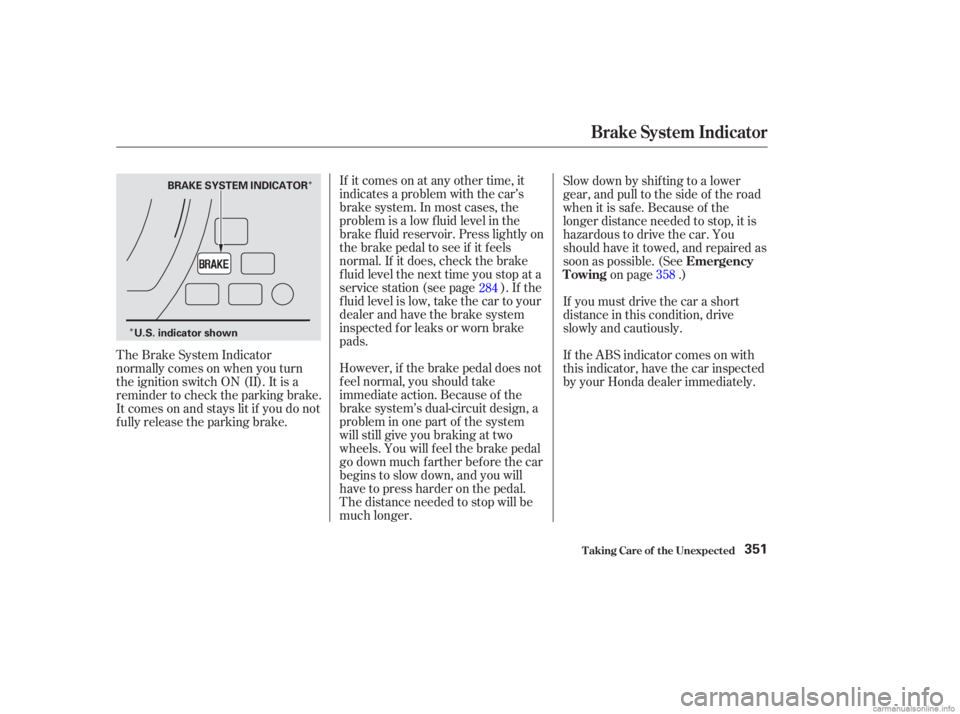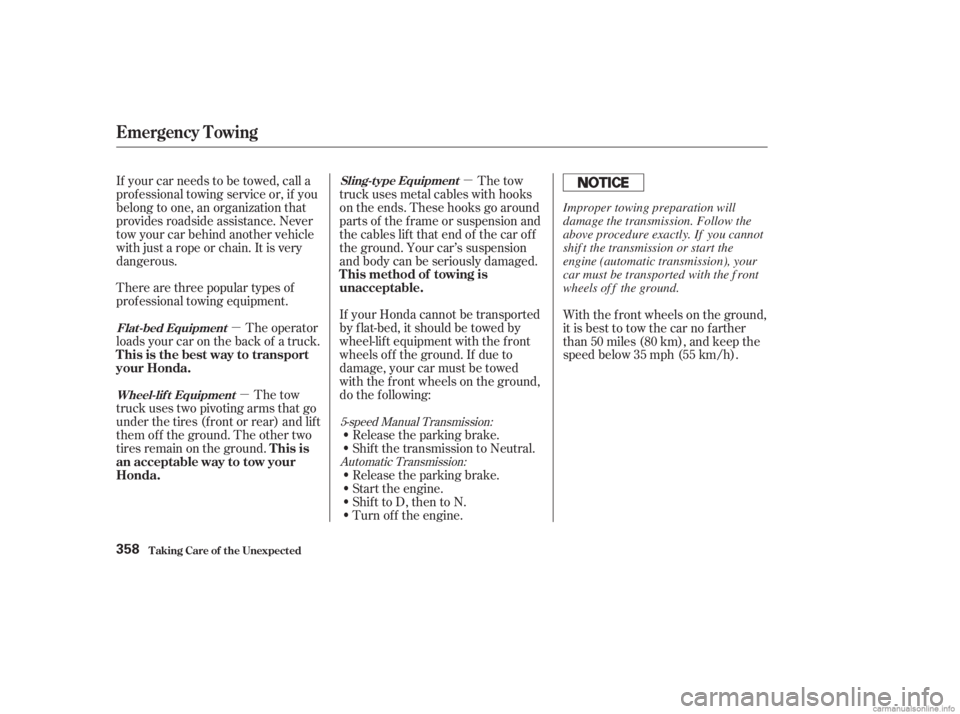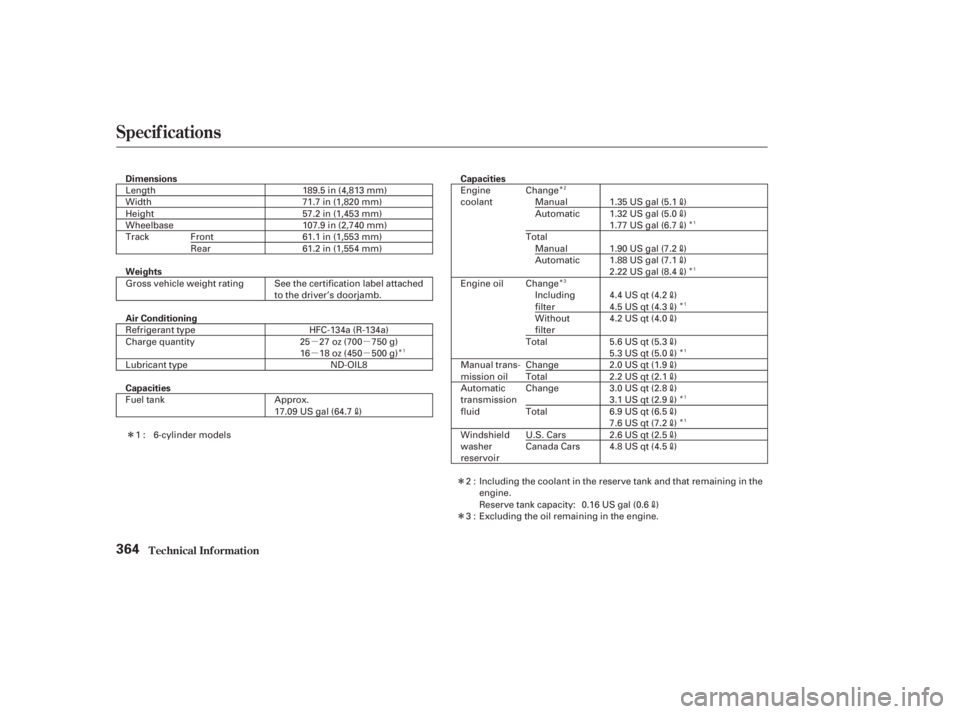Page 340 of 395
CONT INUED
Use the extension and wheel
wrench as shown to raise the car
until the f lat tire is of f the ground.
Do not attempt to forcibly pry the
wheel cover of f with a screwdriver
or other tool. The wheel cover
cannot be removed without f irst
removing the wheel nuts.Remove the wheel nuts and f lat
tire. Temporarily place the f lat tire
on the ground with the outside
surf ace of the wheel f acing up.
You could scratch the wheel if you
putitfacedown.
Locate the jacking point nearest
thetireyouneedtochange.Place
the jack under the jacking point.
Turn the end bracket clockwise
until the top of the jack contacts
the jacking point. Make sure the
jacking point tab is resting in the
jack notch.
9.
10.
11.
U.S. DX and LX models:
Changing a Flat T ire
T aking Care of t he Unexpect ed337
JACKING POINT WHEEL WRENCH
EXTENSION
Page 341 of 395
Put on the spare tire. Put the
wheel nuts back on f inger-tight,
then tighten them in a crisscross
pattern with the wheel wrench
until the wheel is f irmly against
the hub. Do not try to tighten
them f ully.
Bef ore mounting the spare tire,
wipeanydirtoff themounting
surface of the wheel and hub with
a clean cloth. Wipe the hub
carefully,itmaybehotfrom
driving.
Lowerthecartothegroundand
remove the jack.
12.
13.14.
T aking Care of t he Unexpect ed
Changing a Flat T ire
338
BRAKE HUB
Page 342 of 395
Tighten the wheel nuts securely in
the same crisscross pattern. Have
the wheel nut torque checked at
the nearest automotive service
f acility.
Tighten the wheel nuts to:Remove the center cap before
storing the f lat tire in the trunk
well.
Place the flat tire face down in the
spare tire well.
Remove the spacer cone f rom the
wing bolt, turn it over, and put it
back on the bolt.
Secure the f lat tire by screwing
the wing bolt back into its hole.
15.
16.
17.
18.
19.
CONT INUED
LX, EX, and EX-V6 models
Changing a Flat T ire
T aking Care of t he Unexpect ed339
WING BOLT
SPACER CONEFor
normal
tire
For
spare
tire
80 lbf·ft (108 N·m , 11 kgf·m)
Page 343 of 395

Store the jack in its holder. Turn
the jack’s end bracket to lock it in
place. Replace the cover. Store the
tools.
Store the wheel cover or center
cap in the trunk. Make sure it does
not get scratched or damaged.Diagnosing why your engine won’t
start f alls into two areas, depending
on what you hear when you turn the
key to START (III):
You hear nothing, or almost
nothing. The engine’s starter
motor does not operate at all, or
operates very slowly.
You can hear the starter motor
operating normally, or the starter
motor sounds like it is spinning
f aster than normal, but the engine
does not start up and run. When you turn the ignition switch to
START (III), you do not hear the
normal noise of the engine trying to
start. You may hear a clicking sound
or series of clicks, or nothing at all.
Check these things:
Check the transmission interlock.
If you have a manual transmission,
the clutch pedal must be pushed
all the way to the f loor or the
starter will not operate. With an
automatic transmission, it must be
in Park or Neutral.
Turn the ignition switch to ON (II).
Turn on the headlights and check
their brightness. If the headlights
are very dim or don’t light at all,
the battery is discharged. See on page .
20.
21.
342
T aking Care of t he Unexpect ed
Changing a Flat Tire, If Your Engine Won’t Start
If Your Engine Won’t Start Nothing Happens or the StarterMotor Operates Very Slowly
Jump Starting
340
Loose items can fly around the
interior in a crash and could
seriously injure the occupants.
Store the wheel, jack, and tools
securely before driving.
Page 354 of 395

�Î
�ÎIf it comes on at any other time, it
indicates a problem with the car’s
brake system. In most cases, the
problem is a low f luid level in the
brake f luid reservoir. Press lightly on
the brake pedal to see if it f eels
normal. If it does, check the brake
f luid level the next time you stop at a
service station (see page ). If the
fluid level is low, take the car to your
dealer and have the brake system
inspected f or leaks or worn brake
pads.
However, if the brake pedal does not
f eel normal, you should take
immediate action. Because of the
brake system’s dual-circuit design, a
problem in one part of the system
will still give you braking at two
wheels. You will f eel the brake pedal
go down much f arther bef ore the car
begins to slow down, and you will
have to press harder on the pedal.
The distance needed to stop will be
much longer. Slow down by shif ting to a lower
gear, and pull to the side of the road
when it is saf e. Because of the
longer distance needed to stop, it is
hazardous to drive the car. You
should have it towed, and repaired as
soon as possible. (See
on page .)
The Brake System Indicator
normallycomesonwhenyouturn
the ignition switch ON (II). It is a
reminder to check the parking brake.
It comes on and stays lit if you do not
f ully release the parking brake. If you must drive the car a short
distance in this condition, drive
slowly and cautiously.
If the ABS indicator comes on with
this indicator, have the car inspected
by your Honda dealer immediately.
284
358Emergency
Towing
Brake System Indicator
T aking Care of t he Unexpect ed351
BRAKE SYSTEM INDICATOR
U.S. indicator shown
Page 361 of 395

�µ�µ �µ
Automatic Transmission:
5-speed Manual Transmission:
There are three popular types of
prof essional towing equipment.
The operator
loads your car on the back of a truck.
The tow
truck uses two pivoting arms that go
under the tires (f ront or rear) and lif t
them of f the ground. The other two
tires remain on the ground. The tow
truck uses metal cables with hooks
on the ends. These hooks go around
parts of the f rame or suspension and
the cables lif t that end of the car of f
the ground. Your car’s suspension
and body can be seriously damaged.
If your Honda cannot be transported
by f lat-bed, it should be towed by
wheel-lif t equipment with the f ront
wheels of f the ground. If due to
damage, your car must be towed
with the f ront wheels on the ground,
do the f ollowing:
Release the parking brake.
Shif t the transmission to Neutral. With the f ront wheels on the ground,
it is best to tow the car no farther
than 50 miles (80 km), and keep the
speedbelow35mph(55km/h).
If your car needs to be towed, call a
prof essional towing service or, if you
belong to one, an organization that
provides roadside assistance. Never
tow your car behind another vehicle
with just a rope or chain. It is very
dangerous.
Release the parking brake.
Start the engine.
ShifttoD,thentoN.
Turn of f the engine.
Flat -bed EquipmentWheel-lif t Equipment Sling-t ype Equipment
This is the best way to transport
your Honda.
T his is
an acceptable way to tow your
Honda. T his method of towing is
unacceptable.
Emergency T owing
T aking Care of t he Unexpect ed358
Improper towing preparation will
damage the transmission. Follow the
above procedure exactly. If you cannot
shif t the transmission or start the
engine (automatic transmission), your
car must be transported with the f ront
wheels of f the ground.
Page 362 of 395
If you decide to tow your car with all
f our wheels on the ground, make
sure you use a properly-designed and
attached tow bar. Prepare the car for
towing as described above, and leave
the ignition switch in Accessory (I)
so the steering wheel does not lock.
Make sure the radio and any items
plugged into the accessory power
socket are turned of f so they do not
rundownthebattery.
Emergency T owing
T aking Care of t he Unexpect ed359
The steering system can be damaged if
the steering wheel is locked. Leave the
ignition switch in Accessory (I), and
make sure the steering wheel turns
f reely bef ore you begin towing.Trying to lif t or tow your car by the
bumpers will cause serious damage.
The bumpers are not designed to
support the car’s weight.
Page 367 of 395

�µ�µ
�µ�µ
�Î �Î
�Î
�Î
�Î�Î
�Î
�Î
�Î
�Î
�Î
�Î
Specif ications
T echnical Inf ormation364
Capacities
Weights
Air Conditioning
Capacities Dimensions 1.35 US gal (5.1
)
1.32 US gal (5.0)
1.90 US gal (7.2
)
4.4 US qt (4.2
)
4.2 US qt (4.0
)
5.6 US qt (5.3
)
2.0 US qt (1.9
)
2.2 US qt (2.1)
2.6 US qt (2.5
)
Excluding the oil remaining in the engine. Including the coolant in the reserve tank and that remaining in the
engine.
Reserve tank capacity: 0.16 US gal (0.6
)
Engine
coolant
Engine oil
Manual trans-
mission oil
Automatic
transmission
fluid
Windshield
washer
reservoir
1.77 US gal (6.7
)
1.88 US gal (7.1
)
2.22 US gal (8.4)
4.5 US qt (4.3
)
5.3 US qt (5.0
)
3.0 US qt (2.8
)
3.1 US qt (2.9)
6.9 US qt (6.5)
7.6 US qt (7.2)
4.8 US qt (4.5
)
189.5 in (4,813 mm)
71.7 in (1,820 mm)
57.2 in (1,453 mm)
Gross vehicle weight rating See the certification label attached to the driver’s doorjamb.
HFC-134a (R-134a)
25 27 oz (700 750 g)
16 18 oz (450 500 g) ND-OIL8
Refrigerant type
Charge quantity
Lubricant type
Fuel tank
17.09 US gal (64.7
)
Length
Width
Height
Wheelbase
Track
107.9 in (2,740 mm)
61.1 in (1,553 mm)
61.2 in (1,554 mm)
Approx.
Front
Rear
1 : 6-cylinder models Change
Manual
Automatic
Total Manual
Automatic
Change Including
filter
Without
filter
Total
Change
Total
Change
Total
U.S. Cars
Canada Cars
2:
3:
2
3 1
1
1
1
1
1
1